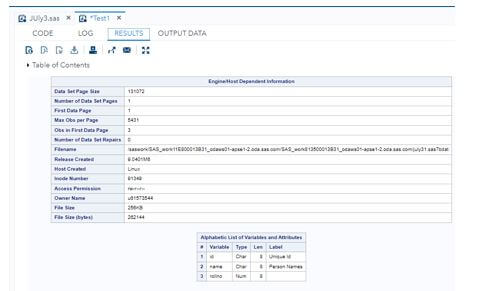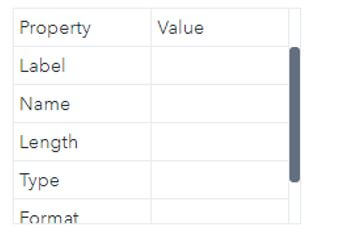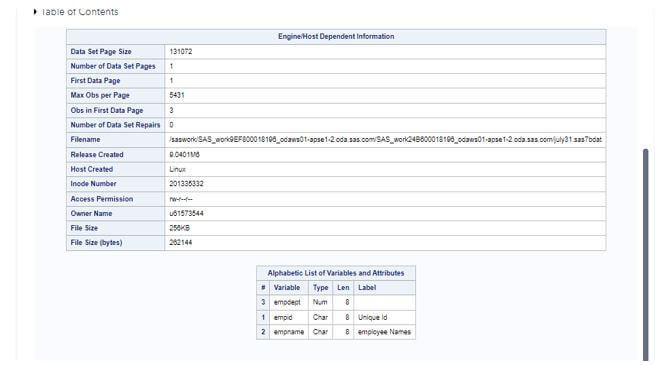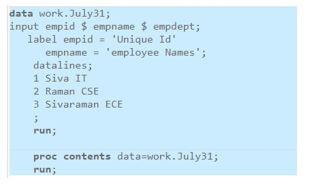Updated March 17, 2023
Introduction to SAS Label
The SAS label is used in the variable with text format input strings and has a limit for reaching the characters that include the special characters. It will be used in the SAS reports and the stored procedures for the flexibility length with additional typographical characters; once the maximum character length is reached, it won’t accept the special characters; the variable label will get only upto 256 characters.
Key Takeaways
- The SAS label is one of the string types, and the text string format is up upto 256 characters.
- It accepts special characters like operators, spaces, alphabets, numeric, and digits.
- The variable value will give a more flexible nature to the character length usage.
- We can use Label=option on input characters. It also accepts output datasets.
- The label statement of the SAS data step is permanently associated with the SAS labels with the specified variables.
What is SAS Label?
A SAS variable label is a type of string or text format variable datatype that accept only 256 characters, including the special characters used in the SAS Report and Procedures. The label will accept only the flexible character length and characters in the user input dataset. For example, if the label value is on mode, then the input datasets assigned the appropriate label for the specified file maximum character length is 32 in the variable name and cannot be accepted as special characters. The variable label is 256 characters, including letters, special characters like numbers, spaces, and additional symbols like percentage signs.
How to Create SAS Label?
We can create a label by using the label keyword in the sql statement that may be followed with the Proc SQL procedure. It will place the label statement directly assigned to the variable name, followed by an equal operator sign and the label quotes.
Like that, the syntax will be followed as below:
Select old column name label = ‘new column name’The above code creates the variable label in the proc datasets procedure by combining the label assigned to the SAS variable. So the syntax of the Label statement is the straightforward approach on the variable name, equal sign, and the data label between the single quotes sign with an attached name. The datas come under the Alphabetic List of Variables and Attributes table on the SAS outputs with an attached column called a label.
Steps to Create SAS Label
Given below are the steps mentioned:
1. Navigate to the below URL.
https://odamid-apse1-2.oda.sas.com/SASStudio/?ticket=ST-59698-3tfrxBZsBrcRMit0HPnA-cas
2. Paste the below code for creating the dataset.
3. data work.July 31;
4. input id $ name $ rollno;
5. datalines;
6. 1 Siva 01
7. 2 Raman 02
8. 3 Sivaraman 03
9. ;
10. run;
11. Then, we can create the label and assign the same to the appropriate SAS dataset column.
12. data work. July 31;
13. input id $ name $ rollno;
14. label id = ‘Unique Id’
15. name = ‘Person Names’;
16. datalines;
17. 1 Siva 21
18. 2 Rahman 22
19. 3 Sivaraman 23
20. ;
21. run;
22.
23. proc contents data=work.July 31;
24. run;
SAS Label Statements
We can create the label statement by using the label keyword in the SAS data step, which is permanently associated with the variables. It will affect the data information of the SAS dataset; it contains the variable data’s information; it can be of any datatype like String, Integer, etc. The label statement can be mainly called and used to create, modify and remove the existing variable label contents. Label statement is assigned to the temporary label; it is more similar to the label option; it can also add the same in the output of the Procedure like Proc FREQ; it is nothing but the frequency table option for the specified label in the single number of quotes. A permanent variable is declared and assigned to it, and the same will be assigned to the variable and its value with the proc contents. The procedure is the data content, and the temporary label is checked and verified with the existing contents while executing the procedure with Proc Print and Proc means.
The result of the SAS codes will make them learn and design the model columns for the SAS dataset.
SAS Label Model
The SAS variable creation is the most important way to create the SAS data step, which helps assign the Label keyword for variable name declaration. We will use the equal operator to declare the label between the old and new values and single quotes of the new value. The sign operator will create the Proc SQL and equal sign of the SAS report version for running the Proc dataset procedure. The maximum label length of the SAS character is 256 bytes which, depending upon the requirement, includes the special characters, symbols, spaces, other operators, etc.
The table will have the Property and Values like the Label, Name, Length, Type, Format, and Informat; these are the types of Properties from the SAS Output data. Next, the Class will create the Query Builder, and the dataset label will follow the exact Icon text.
Example of SAS Label
Given below are the example of SAS Label:
Code:
data work.July31;
input empid $ empname $ empdept;
datalines;
1 Siva IT
2 Raman CSE
3 Sivaraman ECE
;
run;
data work.July31;
input empid $ empname $ empdept;
label empid = 'Unique Id'
empname = 'employee Names';
datalines;
1 Siva IT
2 Raman CSE
3 Sivaraman ECE
;
run;
proc contents data=work.July31;
run;Output:
Explanation:
1. In the above example, we first created the dataset with three defined column attributes.
2. Next, we can create the label by using the Label keyword with an old value equal to (=), the single quote value.
3. Next, we can declare the variable with a specific type along the attribute label values for character length.
Frequently Asked Questions
Other FAQs are mentioned below:
Q1. What is the SAS label?
Answer:
It is one variable type and is defined with the keyword as the Label text format and the string type.
Q2. How to add the SAS label to the SAS dataset?
Answer:
We can use the Label keyword and an equal operator like label = option(or) value. It is accepted with the input and output datasets.
Q3. How many characters are accepted in the SAS label?
Answer:
It accepts only upto 256 characters, including special characters, operators, signs, numbers, digits, etc.
Q4. Mention the advantage of the SAS label statement.
Answer:
It helps to remove the variable from the label enclosed with the single quotes, including blank spaces to remove the existing variable label values.
Q5. How will we add the label to the SAS existing dataset?
Answer:
The flag is enabled using the QB update command and the set_label property.
Conclusion
It is the feature and the statement for performing the SAS data operations in both new and existing datasets. It will have to accept special characters and the procedure from the SAS inputs and output datasets for declaring the labels. The option value is assigned to the label name using the single quotes operator.
Recommended Articles
This is a guide to SAS Label. Here we discuss the introduction, steps to create a SAS label, statements, model, example, and FAQ. You may also have a look at the following articles to learn more –









